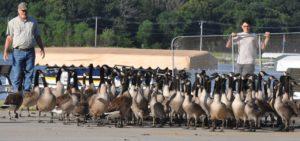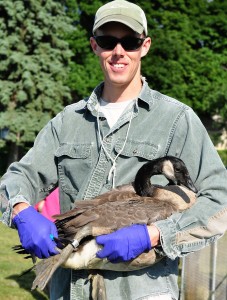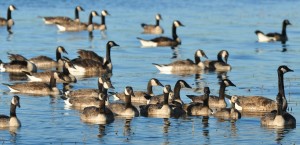Photography courtesy of Lowell Washburn, all rights reserved.
GOOSE RODEO AIDS IN WATERFOWL MANAGEMENT
VENTURA — The trap was set. The noose was tightening. With canoes, kayak, and DNR patrol boat drawing ever closer; the retreating goose flock had little chance for escape. With adult geese rendered temporarily flightless by the summer molt and this year’s crop of youngsters not yet capable of taking to the air, the birds’ only hope was to outswim their pursuers. Paddling across the west end of Cerro Gordo County’s Clear Lake, the flock eventually made landfall at the Lynn Lorenzen public boat ramp. Upon taking to dry ground, the honkers went from frying pan to fire. Greeted by an enthusiastic gaggle of wildlife workers, the scene soon erupted into a genuine Wild Goose Rodeo. Armed with eight-foot-long netted panels, biologists sprang into action, quickly surrounding and herding more than 130 of the giant waterfowl into a compact portable enclosure.
Once the pen was secured DNR wildlifers began extracting the geese, one by one, from their makeshift corral. After recording each bird’s age and sex, the fowl were fitted with individually numbered aluminum leg bands. Once the new jewelry is clamped into place, those shiny ID bracelets will remain with the geese for life. Mission accomplished, conservation workers immediately returned each goose to the water where the birds lost no time in heading for the seclusion of nearby cattails.
According to DNR Waterfowl Biologist, Orrin Jones, Canada goose roundups have become an increasingly common sight in Iowa with similar events currently occurring statewide. Biologists are quick to note that the annual large scale efforts have become a critical component for managing one of Iowa’s most important bird species.
“Our goal is to band 3,500 Canada geese [in Iowa] each summer,” says Jones. “Geese have enjoyed excellent nesting success during the past two years. I think we’ll easily exceed our banding goal this year and will probably capture around 4,000 birds during the next several days.”
Objectives for the Iowa goose drives are clearly defined. Banding enables DNR biologists to document where birds are produced and where they are harvested. When reported by hunters, banding data enables biologists to effectively identify and map flight corridors which allows managers to pinpoint the habitats most critical to migrating waterfowl. Band recovery data also provides crucial information regarding Canada goose survival rates, harvest distribution, and aids in determining how quickly new birds are recruited into resident breeding populations. Canada geese don’t begin nesting until their third year and birds have to survive a lot of things before getting there, said Jones.
During recent decades, goose hunting has become increasingly important to outdoor recreation. Iowa hunters currently enjoy a stable annual harvest of around 50,000 to 60,000 Canada geese. Around 10 percent of the geese banded in Iowa are reported by hunters each year.
“What’s really remarkable is that our current annual goose harvest is nearly equal to the number of mallard ducks bagged in the state each year,” said Jones. No one would have dreamed that Iowa goose hunting would become that important.







 Tom Cope
Tom Cope Sue Wilkinson
Sue Wilkinson Susan Judkins Josten
Susan Judkins Josten Rudi Roeslein
Rudi Roeslein Elyssa McFarland
Elyssa McFarland Mark Langgin
Mark Langgin Adam Janke
Adam Janke Joe Henry
Joe Henry Kristin Ashenbrenner
Kristin Ashenbrenner Joe Wilkinson
Joe Wilkinson Dr. Tammy Mildenstein
Dr. Tammy Mildenstein Sean McMahon
Sean McMahon